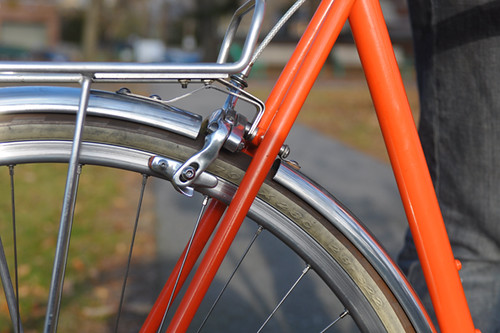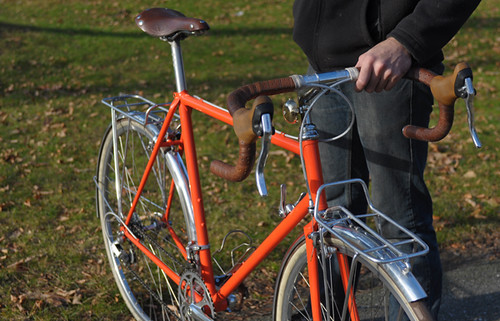There are bicycles that strike you as unique from the first glance, and then there are those that sneak up on you. When Ed showed me the rando bike he'd put together from a refurbished Miyata frameset, it seemed like a nice enough classic build. Fenders, racks, leather, twine. But on closer inspection, all sorts of curious features emerged.
First I noticed the unusual front rack mount. A small DIY bracket at the front curled under and bolted onto the fender.
Initially I assumed this was to add extra stability to the rack. But then I realised the real function of this bracket - in addition to another one extending from the fork crown - was to hold up the fender. Or, more accurately, the front part of the fender.
I had seen split fenders before, but what struck me about these was how subtle they were, how utterly integrated into the overall design of the bike. The split was something I noticed only after my eye led me to it as it moved from one end of the rack to the other.
The tires are 700Cx28mm Gran Compe ENE Ciclo (brown, with tan sidewalls) and Ed was determined to make them fit along with the fenders. The split accomplishes this despite the lack of sufficient clearances under the brake bridge and fork crown.
Both the front and rear racks were recycled from older bikes, and I noticed that the rear one was stamped "Jim Blackburn." This prompted me to look into the history of Blackburn Racks, and indeed they were once called by the name of the founder. The vintage racks - now quite sought after - used a single bracket design to connect to the brake bridge, whereas the Blackburns in current production use a two bracket design to connect to seat stay braze-ons. I also found an interesting article describing Jim Blackburn's contributions to research in weight distribution for loaded touring.
The components seemed like a random mix, until Ed explained that he was going for a Suntour-inspired build: mostly vintage Japanese (but no Shimano), with some modern VO and Dia Compe sprinkled in. While such a thing would never have occurred to me, gathering components that made sense within this paradigm had been an important part of putting the bike together, a game he'd enjoyed playing.
The more we talked about the bike, the more of these things I discovered. Subtle details, hidden meanings. What looked like "just" a nice bicycle at first glance became fascinatingly personal. And that's the thing about bikes. We don't really know what they mean, or represent to the owner. We don't know what the story behind each one is, until we ask. Maybe that's why I still can't seem to walk past a bicycle without a closer look, or at least a second glance.













0 comments:
Post a Comment